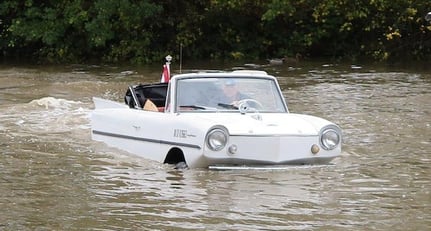1962 Amphicar Amphibious Car
-
Year of manufacture1962
-
Chassis number103911022008
-
Engine numberGK659HE
-
Lot number349
-
DriveLHD
-
ConditionUsed
-
Number of seats2
-
Location

-
Exterior colourOther
-
Drivetrain2wd
-
Fuel typePetrol
Description
1962 Amphicar 770 Cabriolet
Chassis no. 103911022008
Engine no. GK659HE
Industrial designer Hans Trippel's experiments with amphibious vehicles began in the 1930s, bearing fruit in wartime in the form of the Volkswagen based Schwimmwagen, more than 14,000 of which saw service with the German Army in WW2. Trippel revived the concept post-war with the Amphicar (originally called the Eurocar), which was the first amphibious vehicle mass-produced for public sale. It was manufactured initially by Deutsche Industrie-Werke at Lübeck and later in Berlin by Deutsche Waggon und Maschinenfabriken.
Necessarily of unitary construction, the cabriolet-style Amphicar was powered by a 1,147cc four-cylinder Triumph Herald engine mounted in the rear and driving the rear wheels. A special transmission drove the two propellers that afforded a maximum cruising speed on water of around 6 knots (7mph), the top speed on land being around 70mph (112km/h) hence the choice of name: '770'. One owner was quoted as saying that he had 'the fastest car on the water and the fastest boat on the road.'
No special steering gear was required for use on water, the car being guided in the normal way using the steering wheel. The design certainly worked, as demonstrated by a well-publicised stunt that saw a pair of Amphicars successfully cross the English Channel from France to England in 1965 on their way to the Frankfurt Motor Show, while that same year another pair of Amphicars successfully navigated the Yukon River in Alaska. Nevertheless, and despite the attractions of its dual capability, the Amphicar was not a commercial success. In what should have been, and indeed was, its biggest market - the USA - the Amphicar was handicapped by the many difficulties involved in trying to make it comply with emissions and safety regulations. Demand for what was essentially a novelty vehicle never remotely approached the 20,000 units projected annually, a little under 4,000 being constructed before production ceased in 1968. The Amphicar's quirkiness often attracted the attention of filmmakers and it has appeared in several movies, including 'Inspector Clouseau' (1968).
This particular Amphicar spent most of its life in central Canada and has only recently come to the UK. The vendor advises us that it was tried recently on the River Medway and performed well, with no leaks a or nasty noises. Supplied with a fresh MoT, the vehicle is offered for sale following a change in the vendor's plans. The only deviation from factory specification notified is the non-original front seats.







